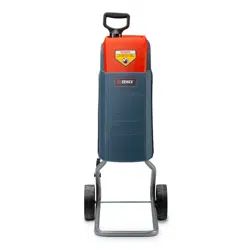Loading ...
Loading ...
Loading ...

EN - 12
WWW.SENIXTOOLS.COM
WARNING:
Only perform maintenance listed in this manual,
any other service should be performed by
authorized services.
ROUTINE INSPECTION
Before each use, inspect the general condition of the tool. If
any of these following conditions exist, do not use until parts
are replaced or the tool is properly repaired.
Check for:
• Loose hardware,
• Misalignment or binding of moving parts,
• Damaged cord/electrical wiring,
• Cracked or broken parts, and
• Any other condition that may affect its safe operation.
CLEANING & STORAGE
1. Keep the ventilation openings free from dust and debris
to prevent the motor from overheating.
2. Use a vacuum or low-pressure compressed air to
remove dust and debris from the tool surfaces, motor
housing and work area.
3. Wipe the tool surfaces clean with a soft cloth or brush.
Make sure water does not get into the tool.
WARNING:
Most plastics are susceptible to damage from
various types of commercial solvents. Do not
use any solvents or cleaning products that
could damage the plastic parts. Some of these
include but are not limited to: gasoline, carbon
tetrachloride, chlorinated cleaning solvents, and
household detergents that contain ammonia.
To clean the inside of the unit, turn the hopper locking knob
counterclockwise, and open the hopper. Clean the cutting
blades and the discharge area. Remove wood sticks or
objects that may clog the blades. Check the blades for
damage and replace if they show signs of wear. Replace
the hopper and lock the hopper locking knob by turning it
clockwise.
4. Store the tool in a clean and dry place away from the
reach of children. Store in temperatures between 41°
to 86°F.
5. Cover the tool in order to protect it from dust and
moisture. It is preferable to store it in its original
packaging with the instruction manual and all
accessories.
PRODUCT DISPOSAL
Used power tools should not be disposed of together
with household waste. This product contains electronic
components that should be recycled. Please take this
product to your local recycling facility for responsible
disposal and to minimize its environmental impact. Please
recycle the packaging and electronic components where
facilities exist.
REPLACING CUTTING BLADES
(Fig. 7)
The shredder comes with two cutting blades preinstalled
that can be reversed or replaced to keep the cutting edges
sharp. The two blades should always be reversed or
replaced as a matched set.
It is recommended to replace/reverse the blades when
the wood sticks can not be automatically drawn into the
shredder after entering the hopper. One set of sharp edges
can cut approximately 400 lbs of materials, depending on
the hardness and quality of the sticks. When the cutting
capacity is reached, make sure to replace/ reverse the
shredder blades to maintain optimal performance.
WARNING:
Wear protective gloves to protect your hands.
Cutting blades have sharp edges on both sides
and are fragile. Handle the blades carefully to
avoid personal injury or damage to the blades.
1. Turn off and unplug the machine. Wait for the blades to
come to a complete stop.
2. Fully unscrew the hopper lock knob until it springs out.
Open the hopper to access the cutting head (A).
3. Clean out all chips or foreign matter sticking to the
cutting head and blades (B) using a soft brush.
4. Rotate the cutting head to the conguration shown in.
To prevent the cutting head from rotating during blade
change, insert a screwdriver through the blade guard
hole (C) and the slot in the cutting head (Fig. 7).
5. Unscrew the two hex bolts (D) on the top blade. Turn the
cutting head 180 degrees to remove the other blade.
6. The blades may be reversed when one of the cutting
edges becomes dull or chipped. Reverse the direction of
the original blades, or install two new blades. Make sure
to reverse or replace both blades at the same time so
they are balanced with one another. Align the slots on the
blade with the grooves on the cutting head.
7. Secure each blade with two hex bolts, rmly tighten them
with a hex wrench. Close the hopper and fully tighten the
hopper locking knob.
Loading ...
Loading ...
Loading ...
